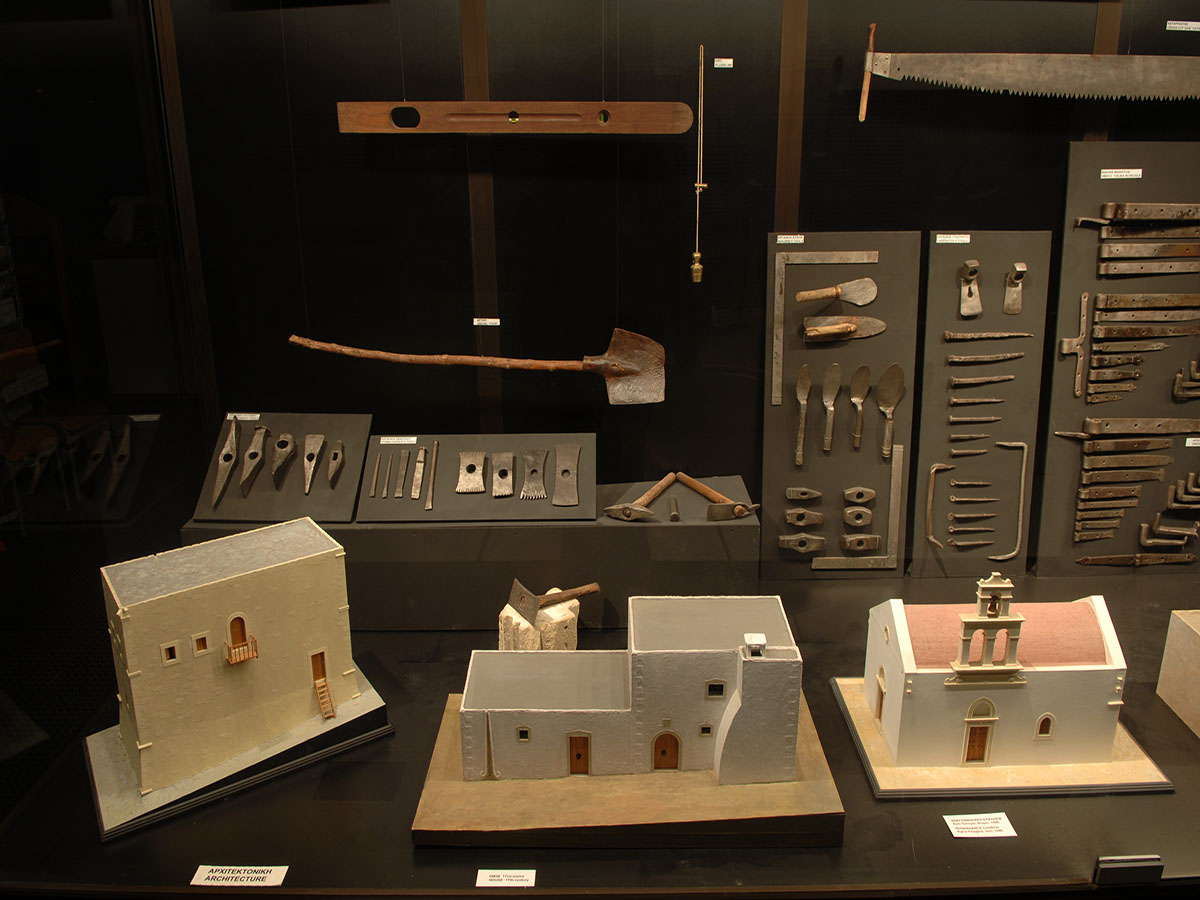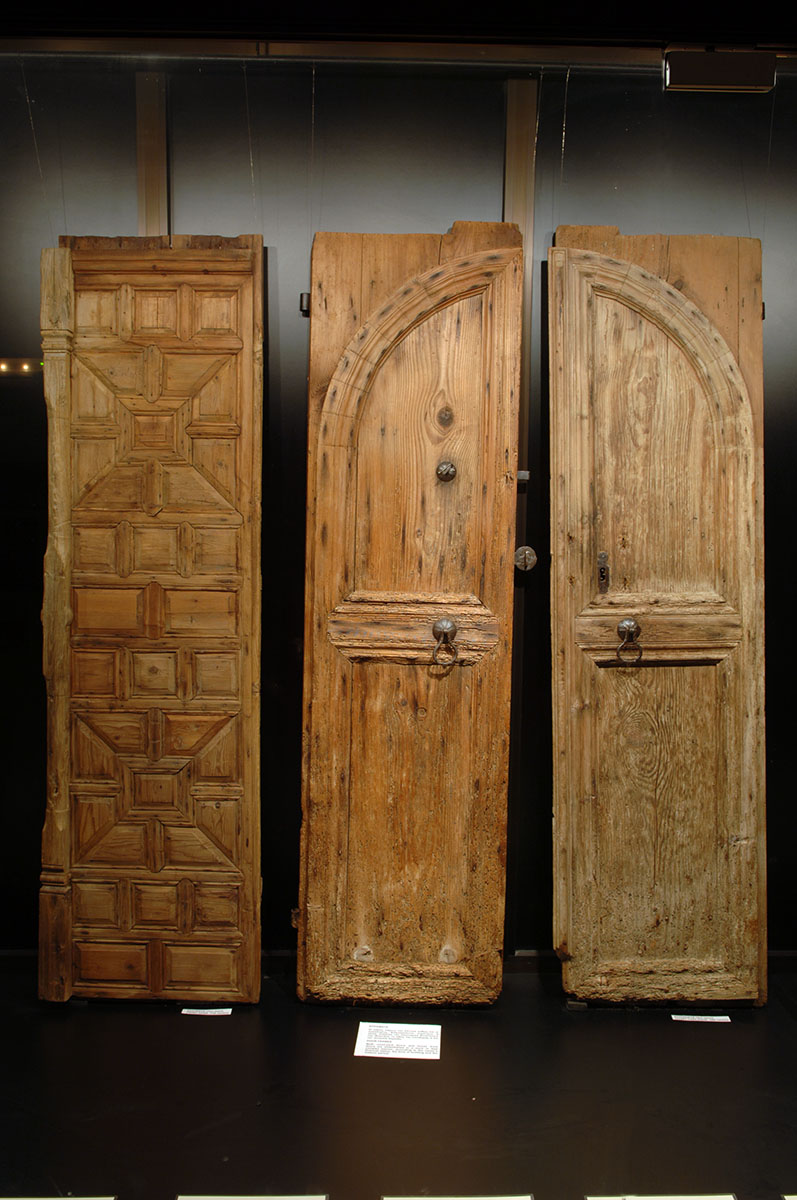Exhibition
Presentation Of Exhibits By Section
Architecture
In Crete there is a wide variety of buildings, from the Middle Ages to the early 20th century.
The exhibition focusses on the various forms of habitation of the last five hundred years, as these constitute the majority of buildings and provide important information on social organisation, the economy and the culture of the society under study.
It must be stressed that in traditional societies there are no architects, but specialist craftsmen called mastores (from the Latin magister, meaning master). These master builders follow the rules of construction of each area and develop them over time. The customer’s only choice is whether he wants the house to be large and expensive or cheap and simple. In both cases, the mastoras will follow the same rules of construction and all the contemporary decorative elements (carved decoration around doors and windows etc.) will be the same – the only difference is the size of the house. This harmonious process was abandoned in the early 20th century with the introduction of reinforced concrete and construction companies.
Quarrying Tools
Deposits of porous limestone are found throughout Crete. The limestone is coloured white to light ochre, and is relatively soft and easy to quarry and work. All buildings were once constructed using this material. Quarrying tools include iron crowbars , picks , drills , large sledgehammers , saws and metal wedges .
BUILDING MATERIAL PREPARATION AND TRANSPORT
The stone intended for use in construction is roughly dressed at the quarry using sledgehammers, chisels and special picks. Due to the lack of wheeled transport, the stone is carried to the building site by pack animals.

House Building
A house is built by the mastoras or master builder and two or three assistants, the mason who dresses large surfaces and carves the decorative elements, the plasterer and his mates, and the carpenter who constructs the roof-beams, floor, doors and windows.
The walls of traditional houses are 50cm thick and are constructed by two builders working simultaneously, one on either side of the wall. For reasons of economy, the mortar used is mud rather than lime and sand.
The builders need to be experienced and the stones must be joined well, with the aid of many small stone wedges. Mud is used to fill in the cracks, preventing insects and reptiles from nesting in the wall.
When construction is complete, the interior walls are plastered with an underlayer of lime, large-grained sand and finely-chopped hay, followed by a top layer of fine sand and lime. Until the Turkish occupation all houses were also plastered on the outside. Due to the island’s economic decline, exterior plastering was then restricted to the mortaring around each stone.
The roof, which is always flat with a slight declination towards the drains, is supported by thick cypress trunks, covered with canes carefully tied together. On top of the canes is a thick layer of bushes, which are covered in turn by 10-15 cm of earth. The earth is covered with a layer of 3-5 cm of pounded clay each autumn to waterproof it.


Furniture
If the house has an upper storey, the floor is comprised of wide planks supported on a row of small beams. The indoor staircase is wooden, while the ground floor is of beaten earth. Any interior partitions are not stone-built but made of planks and a door which never reaches the ceiling. The few doors and windows on the ground floor are barred for safety. Wealthy houses have a large, deep fireplace, while poor houses have a small corner hearth.
The main casements, such as those of the garden gate and main door, are particularly well-made and decorated compared to the simplicity of the rest of the building. The shutters open inwards on the ground floor due to the security bars, and outwards on the upper floor. They are very simply made compared to the doors.
Remarkably, Cretan rural houses have no glass in the windows, even in mountain villages where the winter is cruel. This economy may be due to the Cretan habit of opening doors and windows every morning all year round, regardless of the weather. The houses are well-aired but very cool in winter, although this does not seem to bother the inhabitants.
The doors and windows are supported by special hinges and metal struts. Locks and door-handles of many kinds are used.
Furniture is extremely simple from the time of the Turkish occupation onwards. It is comprised of chairs, armchairs and sofas derived from an ancient Byzantine tradition, small chairs and stools. Storage furniture includes carved wooden chests and large trunks, wardrobes and dressers.
Tables and beds are roughly made because they do not show, being covered by decorative cloths.
